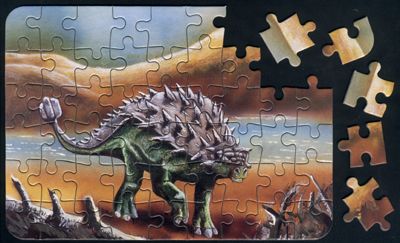March, 2015
Putting the Pieces Together
by Valerie
When people gather for a social occasion, there are many ways in which they can interact. Shared activities may include taking walks, visiting museums or zoos, preparing and eating meals, watching movies, playing games, fishing, dancing, or playing music. Of course, what they do largely depends on just where they are. A family picnic is not the same setting as a friend's house. A household with children probably has the highest need for group activities, especially during the time outside of work and school.
Although my family spent a lot of time outdoors when I was growing up, there was still the inevitable need for things we could do together that were suitable for in the house. Living in Illinois meant fairly long winters, with plenty of twilight hours to fill. One of our most enduring and enjoyable pastimes was working jigsaw puzzles. This is a relaxingly noncompetitive way to stay occupied while also being able to chat. Games that involve winning and losing usually require a bit of concentration, so it is not easy to carry on an absorbing conversation as well. Another nice aspect of puzzles is that they can be left and resumed at any point, so the amount of time spent at them fits a large variety of situations. They are also appropriate for a varying number of participants. From solo to as many as can fit around the table, casually putting pieces in place is a nice way of keeping fidgety hands busy.
We often left a puzzle in progress on our dining room table (we ate in the kitchen), so it was right in the center of the house and not off in some lonely corner. It was also convenient for those few minutes while waiting on others or anticipating the cooking timer. As anyone who lives with several other people knows, there are always odd moments between planned events, and synchronization is an impossible objective.
The jigsaw puzzles we worked always had interesting images. I can still remember a number of them now, nearly 50 years later. Some were educational, like a round one that illustrated all the species of penguins. Others were intriguing, like an Outer Limits themed image showing a strange creature crawling out of the water that was part monster and part fish. I loved fictional animals, especially those that had teeth, fins and scales. Some puzzles were very intricate, or sometimes pattern-intense, and therefore more challenging. A good number were beautiful, with subjects like flowers, birds, and underwater seascapes. A particularly mysterious and lovely image was "Copper Queen," a painting of a horse by Ruth Ray. As a child, I was fascinated by the otherworldly background and the way in which the horse looked ever so slightly distorted, with elongated body and enlarged eyes, but incredibly pleasing and graceful. I was so taken with this image that when I found it, along with three other matching horse paintings, on postcards in a store, I bought them immediately.
 When I was working full time, I often felt so tired at the end of the day that I didn't want to do anything that required thinking or effort. I needed quiet time to just relax, and having a puzzle laid out on a small table in our kitchen was just the thing.
When I was working full time, I often felt so tired at the end of the day that I didn't want to do anything that required thinking or effort. I needed quiet time to just relax, and having a puzzle laid out on a small table in our kitchen was just the thing.
Through the years, I've continued to enjoy jigsaw puzzles, including some of the newer variations. Small, low-cost, 54-piece options are fun as an introduction for very small kids and they have satisfactorily entertained our young nieces and nephews. They also are a form of solitaire that doesn't involve much thought or time. Puzzles with other than straight or round edges are another clever version, as well as those with special shapes in some of the pieces. The puzzles printed on two sides are almost too tricky, unless they are cheaply made and so cut from only one side. It is quite easy then to see the difference in edge character.
To this day, during extended visits with in-laws, assembling a colorful, medium-sized jigsaw puzzle is once again an ideal activity for both adults and youth. We can revel in free-flowing discussions, as it doesn't take much focus to let the eyes and fingers do the work. And if the conversation has a lull, there is no awkward silence because we're still actually doing something.
Even more recently, the computer has made it possible to have jigsaw puzzles created from any image you want. It is certainly not easy to work a puzzle with 500 or so pieces on your computer, as the screen just doesn't allow room to lay out all the bits. It does work okay, though, with less than 100 pieces. There are even those that have parts of the image moving (made by a company called "Living Scenes"). Although working puzzles on a computer certainly lacks the tactile satisfaction of placing the pieces with your fingers, there is a certain novelty to piecing together a scene with flowing water or moving clouds. It's sort of freaky.
When my parents used to enjoy social visits with various friends and relatives, especially those with kids my age, they sometimes worked on puzzles as an entertainment while carrying on lively conversations. These puzzles were usually too difficult and large for small children, so we played amongst ourselves and thought of the puzzle as a "grown up" activity. I remember thinking that a non-interlocking puzzle was next to impossible to work. Those little wavy edges all looked the same!
There are a couple of drawbacks to working jigsaw puzzles in a social setting. The most obvious is that they cover table space that could otherwise be used for plates, drinks and elbows. This resolves itself in several ways, though. The items end up on top of puzzle pieces and folks simply move them about as needed, the pieces get piled up a bit to make room, or, most commonly, the pieces get knocked to the floor, where they may or may not be found later. The condition in which they might be found depends on the personalities and tendencies of the resident dogs. Another possible consequence to working puzzles is that some people just have to finish them. This may result in the gathering continuing past a polite hour or in guests overstaying their welcome. Sometimes a lost piece (or two or three) prohibits that satisfying conclusion that certain personalities find almost a necessity. It's not diplomatic to leave friends, guests, or relatives feeling badly, even if it is just a slight uneasiness about the unresolved end.
One of the most socially awkward mishaps, though, is when a person blunders into the table on which the puzzle resides and knocks it over. The likelihood of this happening increases with the lateness of the hour, the number of people vs. the dimensions of the room, the amount of alcohol that has been consumed, and the number of pieces in the puzzle. It is almost guaranteed that a 5,000 piece non-interlocking puzzle will end up on the floor after it is 90% finished. By that time, however, most of the people involved will not care anymore.
From a quiet solitary pursuit to the focus of a lively social gathering, putting jigsaw puzzles together is "fun for the whole family." It certainly develops a knack for seeing patterns, encourages patience and cooperation, and is an almost surreptitious way to learn about places, animals or art. It is hard not to know and appreciate a famous painting, big cats of the world, or the Eiffel Tower more fully after putting their images together, piece by piece.
 When I was working full time, I often felt so tired at the end of the day that I didn't want to do anything that required thinking or effort. I needed quiet time to just relax, and having a puzzle laid out on a small table in our kitchen was just the thing.
When I was working full time, I often felt so tired at the end of the day that I didn't want to do anything that required thinking or effort. I needed quiet time to just relax, and having a puzzle laid out on a small table in our kitchen was just the thing.

